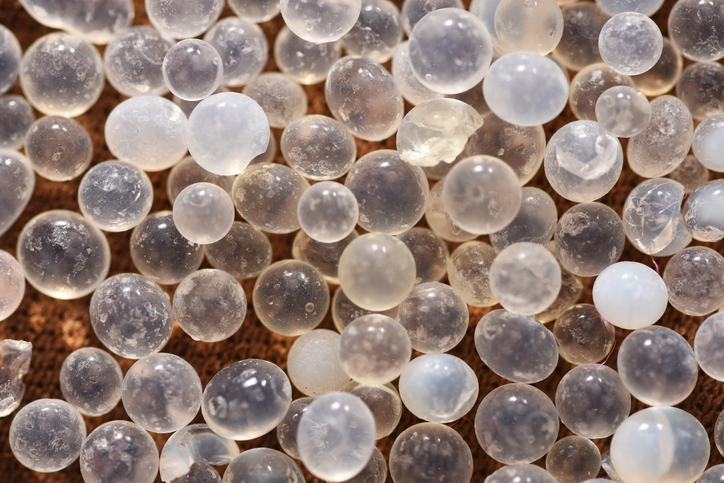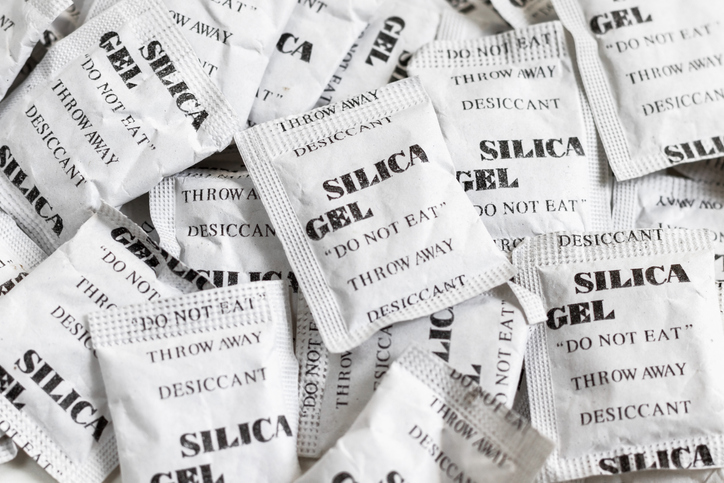You’ll find little packets of silica gel in everything from shoeboxes to bags of beef jerky.
They are often labeled with the words “Do Not Eat, Throw Away”. But if you have delicate items that you are storing away, the tiny silica gel packs you find in countless consumer items can go a long way toward keeping your stuff in tip-top condition. In fact, they prove to be essential moisture absorbers for storage.
Before we talk about how you can reuse silica packets for storage, we’ll first see how they work, where to find them and how to choose the right size and type for your storage needs.
What Are Silica Packs and How Do They Work?
Silica packets contain silica gel, a highly porous material that traps excess moisture from the air. Silica gel beads are made from silicon dioxide, a component you’d find in ordinary beach sand. But don’t let its humble origins fool you; silica gel packets are crafted to be a moisture magnet, or a mini-dehumidifier, if you will.
What these packets do is they pull in water vapor from the air, locking it away. This action, called adsorption, keeps the surrounding environment dry and less hospitable to unwelcome guests like mold, mildew, corrosion and tarnishing, which can ruin most items we put in storage.
Where to Find Silica Packs
Now that you know how useful silica packets are for storage, the next question is: where do you get them?
Thankfully, silica packets are more common than you might think. They pop up in everyday items, from the new pair of shoes you bought to the snack packs you munch on. This widespread use means they’re quite easy to come by. In fact, you’ve probably been throwing them away without realizing their potential.
| Who Uses Them | Types of Items They Go In |
| Packaged Consumer Goods | – Electronics: Cameras, smartphones, etc. – Clothing, footwear, bags – Food products: Jerky, seaweed snacks, etc. – Medications and vitamins |
| Online Retailers & Specialty Stores | – Craft and hobby stores – Home improvement stores – Online marketplaces: Amazon, eBay, etc. |
Accumulating silica gel packets for your own use is simple. Just start saving them from products you buy. And if you need more on short notice, buy them from online retailers and specialty stores.
Do you have a business that needs bulk quantities for extensive storage needs or commercial applications? Consider industrial suppliers. Just remember to check the size and absorption capacity when buying; larger packets are better for bigger spaces.
Pro tip: Keep a dedicated container to store these packets as you come across them.
How To Choose the Right Size and Type of Silica Packets for Storage
Silica gel comes in two main types: indicating and non-indicating. The one we usually stumble upon is the non-indicating silica gel, as it is less expensive and commonly used in general storage situations.
The indicating silica gel is called that because it changes color to show when it’s saturated and needs replacing or reactivating. The colors it comes in are blue and orange. Blue silica gel contains cobalt chloride and changes from blue to pink when saturated. Since cobalt chloride is toxic if ingested, the orange silica gel is more widely used nowadays. This one turns from orange to green and is safer.
To make the right choice, consider the type of items being stored:
- For valuable or sensitive items, indicating silica gel can be more useful as it signals when to replace or recharge the packets.
- For general storage, non-indicating silica gel is cost-effective and efficient.
Besides different types, there are also different sizes of silica packets, suited for various storage spaces. Here’s a simplified guide for effective moisture control:
| Size (Grams) | Suitable for |
| 1g | Small spaces like a drawer, a shoebox or a regular jewelry box. |
| 5g | Small to medium-sized storage bins — 28 liters / 1 cubic foot of airspace |
| 10g | Laundry hampers, camping or expedition rucksacks, wardrobe sections. |
| 25g | Extra-large travel suitcases and guitar cases. |
| 500g | A small storage shed — up to 100 cubic feet |
Best Practices for Using Silica Packets in Storage
Silica gel storage packets work best in airtight or sealed environments, so check for any gaps or openings in storage containers to maximize their efficiency. And, of course, check regularly and replace the packets when needed in long-term storage, especially in environments with fluctuating humidity levels.
Silica gel significantly reduces the risk of rust on metal objects, mold on fabrics and degradation of paper-based items. Here’s a more tailored approach on how to use silica packets when storing different types of belongings:
- Place packets near the most moisture-sensitive items, in a way that they do not directly touch them, especially if made of metal or with electronic components.
- For items stored in layers, like documents or clothing, intersperse silica packets between the layers for even moisture absorption.
- Tuck a silica packet in shoe boxes, storage bins with clothes or even within the pockets of stored garments. This helps prevent mold and musty odors, especially in leather shoes and jackets.
- Slip silica packets in the storage box of important documents and books to prevent them from absorbing moisture, which can lead to warping and mildew.
- Keep silica packets in tool boxes or drawers where tools are stored. This is particularly important for metal tools that are prone to rusting.
- For cameras and lenses, place silica packets in your gear bag or storage box to prevent fungal growth and lens fogging.
Recharging and Reusing Silica Packets
One of the great aspects of silica gel packets is their reusability. This makes them both environmentally friendly and cost-effective. In fact, with proper recharging, they can last for years. This means they get to provide effective moisture control again and again.
If using the indicating silica gel type, the color change will show you when they are dry and ready to be used again. Here’s how you can recharge them for repeated use:
Method 1. Baking
Silica gel can be reactivated by baking. This process evaporates the moisture they’ve absorbed, making them as good as new.
- Spread the packets or loose beads evenly on a baking sheet and put them in the oven at a low temperature — a safe range is between 200°F to 250°F.
- Baking time varies depending on moisture level and oven temperature. Generally, 1 to 2 hours should be enough.
- If your silica gel has an indicator (color-changing), watch for the color to change, signaling that it has been recharged.
- To avoid burns, allow the silica gel to cool down to room temperature on the baking sheet.
- Once cooled, store the silica gel in an airtight container to keep it dry until its next use.
Method 2. Microwaving
For bulk desiccants and urgent needs, you can use a microwave, although this method is generally not recommended, as microwave ovens cannot regulate silica gel temperature very well.
To make sure you don’t overheat and damage the material, use this method only with indicating silica gel. As a rule of thumb, microwave loose beads in a shallow pan for 3-5 minutes on medium power. If the color doesn’t change after 5 minutes, mix with a spoon and repeat.
Always look for the manufacturer’s instructions to make sure you don’t damage the silica gel.
How To Use Silica Gel Packets in Different Environments
Using silica packets effectively depends on the storage environment as the gel effectiveness can decrease in extremely high temperatures or humidity levels, whereas in colder, drier climates and spaces, silica packets may last longer before needing replacement. Here are some tips:
- Using silica gel packets for storing clothes in closets and dressers? Place one in each drawer or on shelves to prevent musty odors and mildew.
- Garages and basements tend to be more humid than the rest of the house. Use larger silica packets to combat excess moisture that can cause rust or mold on tools and stored items.
- Heat in attics can accelerate moisture absorption. Place silica packets with stored items, especially those sensitive to temperature changes like photographs or electronics, but make sure they don’t touch directly.
- Storage units vary widely in climate. Use silica gel packets to protect against fluctuations in humidity, especially if the unit is not climate-controlled.
Where Not To Use Silica Packets
Not all the items we store require moisture control and, even when they do, silica gel packets may not always be the best solution. Here are situations where they may not be necessary or even advisable:
Extremely dry environments. In already dry conditions, additional moisture absorption is unnecessary and could potentially damage certain items, like wood, by overdrying them.
Food storage. While silica gel can be used with some dry food products, it’s not recommended for direct contact with food. Opt for bentonite clay packs instead. (Also, never store food inside of a self-storage unit!)
High-value or sensitive items. For extremely valuable or sensitive items, silica gel may not be enough. Consider professional preservation methods instead of or in addition to the gel packs.
Choose Your Moisture Absorber Packets for Storage
We’ve covered a lot about silica gel packets — from their prime spot in shoeboxes to their role as quality moisture absorbers for storage. The main takeaway is that by understanding how to use silica gel packets, you can protect everything from electronics to clothing and important documents from moisture damage. After all, when you store something, you want it preserved, not just out of the way.
So, whether you’re dealing with humid basements or hot attics, storing seasonal items and tools or preserving wooden furniture and leather goods, we encourage you to put these silica gel storage tips into action.




